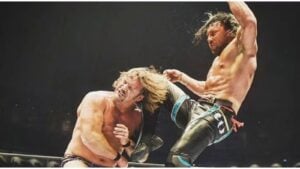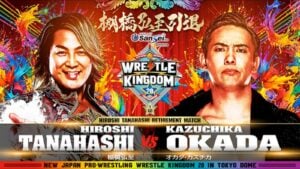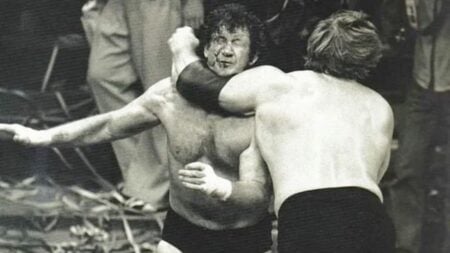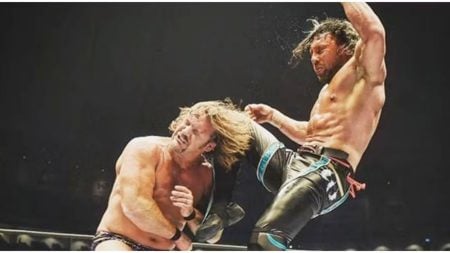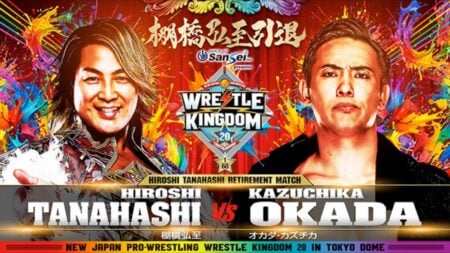It was the Singles Match of the Decade. In early 2000, Tokyo Sports, one of the most prestigious sports magazines in Japan, held a poll to determine the best singles match of the 1990s. The match we’re looking at today was the top choice. It took place on October 31st, 1998, and was hailed as not only the best match of that (already-stacked) decade but also as one of the best of all time.
Today we look back at another great singles match between Mitsuharu Misawa and Kenta Kobashi.
A Storied Past
Misawa and Kobashi were once tag team partners. They spent six years teaming together, from late 1990 to mid-1996. In that time, Kobashi rose from being the inexperienced third man that took the falls in Misawa’s big tag matches to his trusted right-hand man. In 1995, Kobashi had his first world title challenge against Misawa and lost. But even though he lost, he left the match way better than how he entered. From there, a long-term story emerged. The story of Kobashi wanting to reach Misawa’s level.
That desire spurred Kobashi to (respectfully) leave Misawa’s side to strike out on his own. At first, Kobashi achieved some success; in July 1996, Kobashi defeated Akira Taue to win his first Triple Crown Heavyweight title. Sadly for him, he lost it to Misawa six months later and failed to regain it from him ten months after that. A year-and-a-half after that, Kobashi beat Misawa’s bitter archrival Toshiaki Kawada to win his second Triple Crown. And after beating Jun Akiyama in his first defense, along came Misawa to challenge him once more.
Despite being champion, Kobashi found himself in the role of the underdog. He had the gold, sure, but history was not on his side. Since All Japan’s wins and losses mattered a lot, Kobashi found himself 0-3 in big non-tournament singles matches against Misawa. This time, he hoped things would go differently. He also had two things going for him here.
First, he was the first (and thus far, only) man to ever kick out of Misawa’s ultimate finisher, the Tiger Driver ’91. Second, a week before this match, Kobashi debuted his new secret weapon: the Burning Hammer. Kobashi started using this move and announced it was specifically intended for Misawa. And since Kobashi pinned Misawa cleanly with that move already, he hoped that lightning would strike twice in the same place.
The War Begins
Like their legendary January 1997 match, this epic was over forty minutes long. To keep the fans engaged for such a long time, Misawa and Kobashi started things off…simplistically. The opening ten minutes were fairly straightforward with some basic grappling, strike exchanges, and tests of strength. But this slowness was intentional; it showed that, despite the disadvantage mentioned earlier, Kobashi and Misawa were, in fact, on a level playing field here.
Then things kicked into higher gear as the heavier moves started coming in. Kobashi narrowed his focus and started chopping the hell out of Misawa’s neck. Misawa kept hitting stiff elbows and kicks and even landed corkscrew Pescado out of the ring. Keep in mind this was a legit 240-pound man doing something meant to be done by much lighter wrestlers. But that cockiness ended once Misawa went for a dive, and Kobashi literally kicked him in midair.
The Champion Presses Forward
With Misawa’s momentum halted, Kobashi began wearing him down as much as he could. He continued destroying Misawa’s neck with everything in his arsenal to soften him up for a finishing blow later on. He did everything from more neck chops to leg drops across to the throat to even simpler things like headlocks. All of those things put more and more pressure on Misawa’s neck, which Kobashi hoped would increase his chances of scoring a three-count.
But each time Kobashi took three steps forward, Misawa pulled him back by at least two. Even though Kobashi spiked Misawa with one sick suplex after another, Misawa fired back with kicks and elbows. It soon became clear that Misawa was regaining control and kept it for longer. In fact, the only way Kobashi could really land anything of substance was by hitting a last-second counter. But soon, those too started to become less frequent.
By the thirty-minute mark, the match became a true tough-man contest, a brutal war to see which one could withstand more punishment. Kobashi stuck to his strategy and brutalized Misawa’s neck with one sick move after another, including a Bucklebomb/DDT/dragon suplex combination. Soon after, Kobashi started spamming his various finishers. Unlike most wrestlers, Kobashi and his AJPW brethren had multiple finishers for different situations that kept fans guessing when and how his matches would end. And so it began for Kobashi.
Running lariat. Misawa kicked out.
Orange Crush Bomb. Misawa kicked out.
A second running lariat. Misawa kicked out.
Two Burning Hammer attempts. Misawa escaped both.
Diving guillotine leg drop (the move Kobashi used to win his first world title). Misawa survived that too.
Two attempts at a Burning short-range lariat. Misawa blocked those.
Yet another attempt to wreck Misawa’s neck with a Bucklebomb. Misawa countered into a Frankensteiner.
And with that, the tables turned once more. What had worked for Kobashi earlier had now become his own undoing. A sudden last-second counter was all Misawa needed to begin his comeback. He followed that counter with a Tiger Driver from the apron to the floor, which has since become one of Misawa’s biggest career moments.
Back in the ring, Kobashi could barely stay standing. Each time he landed a chop, he staggered around the ring like a drunk. He barely had the wherewithal to dodge any attacks and just took one punishing hit after another. But what Kobashi did still have was muscle memory. Soon afterwards, he found himself in a familiar position: getting spiked with a Tiger Driver ’91. And even though he had no idea where he was, he was still tough and determined enough to kick out of that super-finisher. And once more, it send the crowd into a frenzy.
A Climactic Ending
From there, Misawa knew he had the match won. All that was left to find out was how much it would take before Kobashi finally broke. He had long wrestled like a runaway freight train that kept hitting his opponent until either they stopped moving or he did. And this case, Kobashi was very close to being done. so Misawa went back to the basics; he started landing simpler moves, ones that brought him victory in the past.
First, there was a rolling elbow smash, but that wasn’t enough. Then there was a Tiger Suplex, but Kobashi survived that too. Then there was a running elbow smash, the same move that felled Kobashi in January 1997. But this time around, he not only survived but got to his feet.
Seeing no other option, Misawa charged forward. And so too did Kobashi. The two warriors collided. Misawa hit harder with an elbow strike. But Kobashi stayed put. So Misawa answered with a vicious one-two elbow combo. Kobashi staggered and then slowly slumped to the canvas. Misawa pinned him. And became champion for the fourth time.
The Price of War
For the first time in…possibly ever…Misawa did not follow this match with the typical in-ring champion’s interview. There was no extended celebration, no handshake with the former champion, no photo-op. Instead, Misawa was led to his locker room by his friends. And there we were, given a glimpse of what this match cost him.
Misawa lay on the floor with a towel around his neck as his gophers/aides pressed their weight onto his legs. This was done to help him restore feeling into his body and make sure his nervous system was still working properly. After a minute or so of this, Misawa made it to his feet. But the damage he endured – from both Kobashi and from his own risks – made it hard for him to even walk.
He had to put his hands on his teammate Yoshinari Ogawa’s shoulders, and Ogawa had to lead him forward. Misawa did complete the post-match interview eventually, but the toll on his body was more obvious than ever before.
The Singles Match of the Decade –
A Monumental & Epic Encounter
Over twenty years have passed, and this is one of the AJPW classics that still hold up incredibly well. It’s a 43-minute masterclass in endurance, brutality, and grit. Misawa and Kobashi went to greater heights than ever before to put on a pro-wrestling match for the ages.
If you’re a fan that likes seeing crazy, death-defying wrestling moves, this match has that and then some. If you like careful storytelling, there’s some of that too. And if you simply want to watch two people beat each other senseless out of sheer morbid curiosity, then this match will satisfy you for sure. It’s a true epic in pro-wrestling history, and it definitely warrants revisiting on its anniversary.


